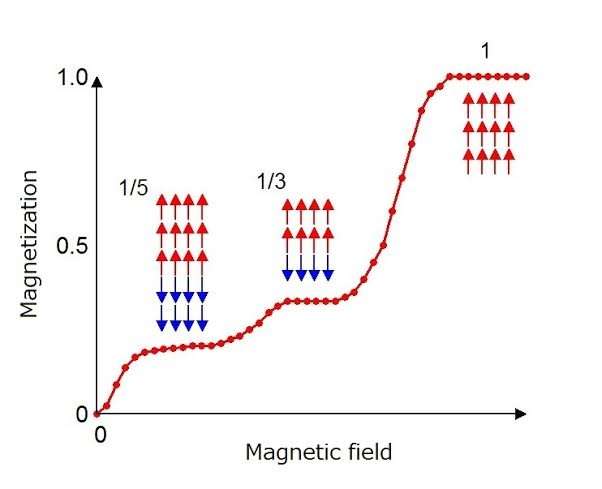June 24, 2015 feature
Physicists observe magnetic 'devil's staircase'

(Phys.org)—Many hiking trails feature a "devil's staircase"—a set of steps that are often steep and difficult to climb. The devil's staircase is also the name of a mathematical function whose graph exhibits a jagged step-like organization reminiscent of a real staircase, although in a highly ordered fractal pattern. Devil's staircase behavior emerges in a variety of areas, such as in crystals, phase transitions, and statistical physics.
Now in a new paper published in Physical Review Letters, researchers led by Hiroki Wadati, an associate professor at the University of Tokyo, have observed devil's staircase behavior in a certain magnetic material: the cobalt oxide SrCo6O11. By analyzing the microscopic behavior of this material, the researchers found that it contains a large number of magnetic structures that have nearly "degenerate," or equal, magnetic energies. The coexistence of these many nearly degenerate magnetic structures gives rise to the devil's staircase behavior, which has the appearance of many (in principle, an infinite number of) proportional step-like structures.
Although the devil's staircase behavior emerges from microscopic effects, the behavior is also reflected in the material's macroscopic properties. One of the most intriguing properties is the material's giant magnetoresistance, which means that an applied magnetic field changes the material's electrical resistance. This property could have implications for designing artificial materials with novel functionalities.
To uncover these microscale magnetic properties of the cobalt oxide, the researchers used a technique called soft X-ray scattering (RSXS), which involves bombarding a material with X-rays and measuring the energy and momentum of the scattered X-rays. As a relatively recent development, RSXS has proven to be a powerful tool for investigating the ordered structures in solid materials. For one of the first times ever, the researchers here used RSXS with magnetic fields of several Tesla. The technique enabled the researchers to discover several microscale magnetic structures that escaped detection in earlier experiments.
The scientists attribute the material's unusually large number of nearly degenerate magnetic phases—and the resulting devil's staircase behavior—to competition between the magnetic phases. This competition results in magnetic frustration, as no single phase is strong enough to dominate the others. The results show that strong magnetic frustration is a key ingredient for giving the material its giant magnetoresistance and also makes the material highly sensitive to very low chemical doping.
To demonstrate this sensitivity, the researchers showed that substituting just 3% of the strontium atoms with barium atoms destroys almost all of the material's degenerate magnetic phases, which greatly changes its overall magnetic properties. Because the material's properties are easily tunable in this way, the scientists hope that this research may offer a path toward engineering and controlling the material's magnetic and electrical properties for various technological applications.
"In future resonant soft X-ray diffraction studies, one can expect to find similar devil's staircase behavior in other materials," Wadati told Phys.org. "The devil's staircase behavior may lead to the development of novel types of spintronics materials, which can use discrete levels of electrical resistivity."
More information:
T. Matsuda, et al. "Observation of a Devil's Staircase in the Novel Spin-Valve System SrCo6O11." Physical Review Letters. DOI: 10.1103/PhysRevLett.114.236403
Also at arXiv:1412.7945 [cond-mat.str-el]
Journal information: Physical Review Letters
© 2015 Phys.org




















